Sealspotting
14 June 2009 | Reviews
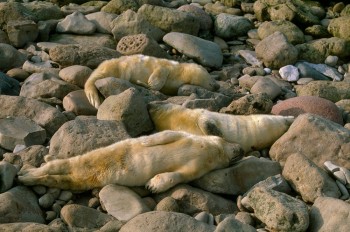
Zzzzzzz! In the grey seal kindergarten babies take a nap after dinner. – Photo: Seppo Keränen
Taskinen, Juha
Paluu Saimaalle
[Return to Lake Saimaa]
Helsinki: WSOY, 2009. 204 p., ill.
ISBN 978-951-0-33745-5
€ 38.90, hardback
Keränen, Seppo & Lappalainen, Markku
Hylkeet [The seals]
Helsinki: Maahenki, 2009. 151 p., ill.
ISBN 978-952-56-5266-6
€ 45, hardback
Sälar
Helsingfors: Söderströms, 2009.
151 p., ill.
Swedish translation: Annika Luther
ISBN 978-951-52-2603-7
€ 45, hardback
The private life of the species of seal that lives only in Lake Saimaa has been carefully investigated lately. Almost everything about this highly endangered species has been revealed, thanks to technological devices such as transmitters that can be glued to their backs…
STOP! WARNING: as I realise that not everybody wants to know what pinnipeds do in their spare time, I suggest you quit reading now, if you aren’t interested in the lives and fates of an obscure group of about 260 mammals that live in a lake in the remote west of Finland.
But they are beguiling creatures. An urbanite bitten by the wildlife bug while holidaying on Lake Saimaa, I first succumbed to the charm of the Saimaa ringed seal (Phoca hispida saimensis), and wrote about it for Books from Finland 2/2005.

The landscape of Lake Saimaa: the endangered ringed seal and the osprey live in these waters and on the almost 14,000 islands of Greater Saimaa. – Photos: Juha Taskinen
This spring there has been heated debate in the Finnish media about whether Finland really wants to commit itself to the protection of the Saimaa ringed seal before it disappears from the waters of the Earth.
The ringed seal was trapped in Lake Saimaa, the fourth largest lake in Europe, near the end of the last ice age, some eight or nine millennia ago, as the land began to rise, cutting the lake off from the sea.
Ever since Finns began to inhabit the shores of the Saimaa after the ice age, they have contributed in many ways to the extermination of the ringed seal (in Finnish, norppa, from the Russian nerpa; see here for a four-minute video clip of norppa in its own environment, with a commentary in Finnish). It was hunted to near extinction until it was finally protected by law in the mid 1950s, after which it suffered heavily from environmental pollution – mercury, DDT and PCBs. Inland waters have become cleaner since the 1980s, so the seal has survived; but now, as global warming affects winter temperatures, its procreation is threatened. The mother seal needs to dig a lair in the snow for her pup during its first few weeks. If the pup is born on the ice, it may not survive. When the weaned pup starts exploring its surroundings in April as the ice melts, it will encounter a new, too often fatal danger under the surface: every spring many young seals – an estimated 30 per cent – drown in fishnets.
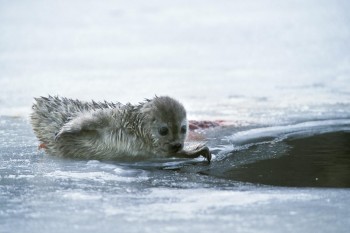
Born on ice: this seal pup, named Voitto (Victor), was born in a winter with little snow, so his mother couldn’t dig the lair he needed. - Photo: Juha Taskinen
Wildlife experts have repeatedly stressed the need to abstain from fishing with nets between 15 April and 30 June, and free fish traps have been offered to all local fishermen who give up fishing with nets during this short period. However, some of them refuse, claiming it is their ‘ancient right’ to fish how and when they please. The consumption of fish by the small Saimaa seal population does not threaten any kind of fishing: a seal eats a kilo of small fish per day, mostly perch and roach. Nowadays only about 20 people make a living by fishing on Lake Saimaa.
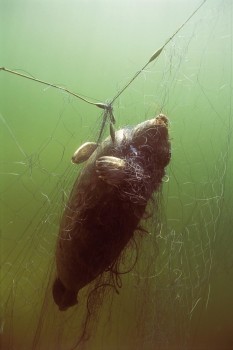
Another premature death: a young seal drowned in a net. – Photo: Juha Taskinen
The Finnish government has expressed its concern – but a law prohibiting net fishing during those crucial weeks has not been passed, indicating that Finland does not have the political will to offer effective protection to a critically endangered indigenous mammal which is rarer than the giant panda.
Juha Taskinen, a nature photographer and guide, has committed himself to the protection of the ringed seal in his native Savo province. In Paluu Saimaalle, a beautiful and touching book, he presents, in words and photos, portraits of the inhabitants of Saimaa in all seasons, telling stories about fishing by humans and pinnipeds, as well as otters and ospreys.
Sealspotting is not easy for the inexperienced: the shy norppa keeps away from humans, and its ringed fur is an excellent camouflage. Thanks to underwater photography and transmitters, the sublacustrine secrets of the seals have been explored.

I’m hungry! Voitto, whose fur is full of frozen lumps of snow, cries for mummy, who emerges from under the ice to feed her pup regularly. This little seal miraculously survived his critical first weeks, but in early spring he was found drowned in a fishnet. - Photos: Juha Taskinen
Taskinen tells how he once caught a seal with his bare hands. He was expecting to be joined by a colleague immediately and got hold of his slippery research subject in the water, but the seal didn’t like the idea of being hugged by a human and decided to leave. Taskinen managed to grab the seal’s back flippers, but as his numb hands were slipping in the cold water, he took one of the flippers between his teeth, just for a second, to get a better grip with his hands – and then accidentally bit the wriggling beast. As Saimaa seals are gentle predators, this one didn’t even try to bite back. Finally the seal was successfully equipped with a transmitter and a flipper tag and released back into his aquatic kingdom, unharmed, save for a minor bite on a flipper and perhaps a firm resolve to never be hugged again.
Later Taskinen thought he should find out whether the seal might have been injured by his bite, so he called a doctor, who rooted around in his medical reference material for a while, concluding that a seal bite isn’t dangerous. There was a long silence on the phone when Taskinen explained again that his was actually a case of man biting dog.
![]()
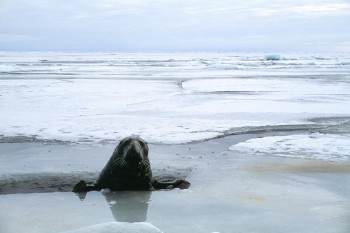
On guard: male grey seals watch over the females feeding their pups on the ice. – Photo: Seppo Keränen
The ancient cousins of the Saimaa seal, the Baltic ringed seal (Phoca hispida botnica) and the grey seal (Halichoerus grypus), live in the Baltic sea, where they too were trapped around 10,000 years ago. The grey seal gives birth on the ice, not requiring a lair in the snow as the ringed seal does.
Hylkeet, Sälar, written by Markku Lappalainen with photogaphs by Seppo Keränen, charts the marine landscape of the Baltic, its people and animals, often in impressive panorama shots. The stony, barren and shallow shoreline, its birds and animals as well as the traditional lifestyles of the people are portrayed with interesting facts and details in the text and in the photographs taken in all seasons.
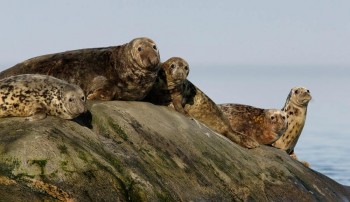
Group portrait: grey seals of the Baltic live in flocks and are not as shy as their Lake Saimaa cousins. – Photo: Seppo Keränen
Hunting and, increasingly, marine pollution, have critically reduced the Baltic seal population over the past century. In the mid 1980s the World Wildlife Foundation started a protection campaign, which has been successful. The seals eat mostly Baltic herring, but as they consume the same fish as people do, competition on the sea has grown harsher recently. Large, strong and clever, the seals eat fish out of nets, which, unlike the smaller ringed seal, they also destroy. They also consume more salmon now, as their favourite, cod, has almost disappeared from the Baltic.
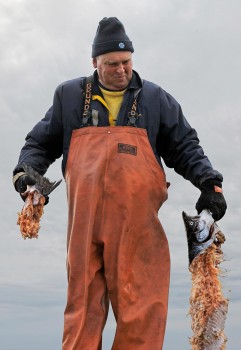
Sad catch: Heikki Salokangas’s family has fished for 200 years in the Gulf of Bothnia. The grey seal in the Baltic has learned how to plunder nets.. – Photo: Seppo Keränen
In the past the seals have been valuable prey, providing food, train oil, skin and fur. Hunters have also been paid for killing them, to protect human fishing. Now hunting the grey and the ringed seal is allowed during certain periods, but as seals are not easy to catch, only about half of the quota is used up annually. The market for seal products in the European Union isn’t large either. Some of the professional fishermen believe that their trade will soon become extinct as a result of the fast-growing grey seal population. It is estimated that a tenth of all grey seals of the world now live in the small Baltic Sea, which is devoid of polar bears, their only natural enemy (save man).
Both Paluu Saimaalle and Hylkeet richly chronicle the history of the age-old relationship of two mammals, man and seal, both adapted to living in arctic climates. Both eat fish, but the seal survives on fish alone. Only man has a chance of controlling the environment, and the fate of both seals and fish is in his hands – as is his own.
Tags: animals, Finnish nature, fishing, photography, wildlife conservation
No comments for this entry yet
